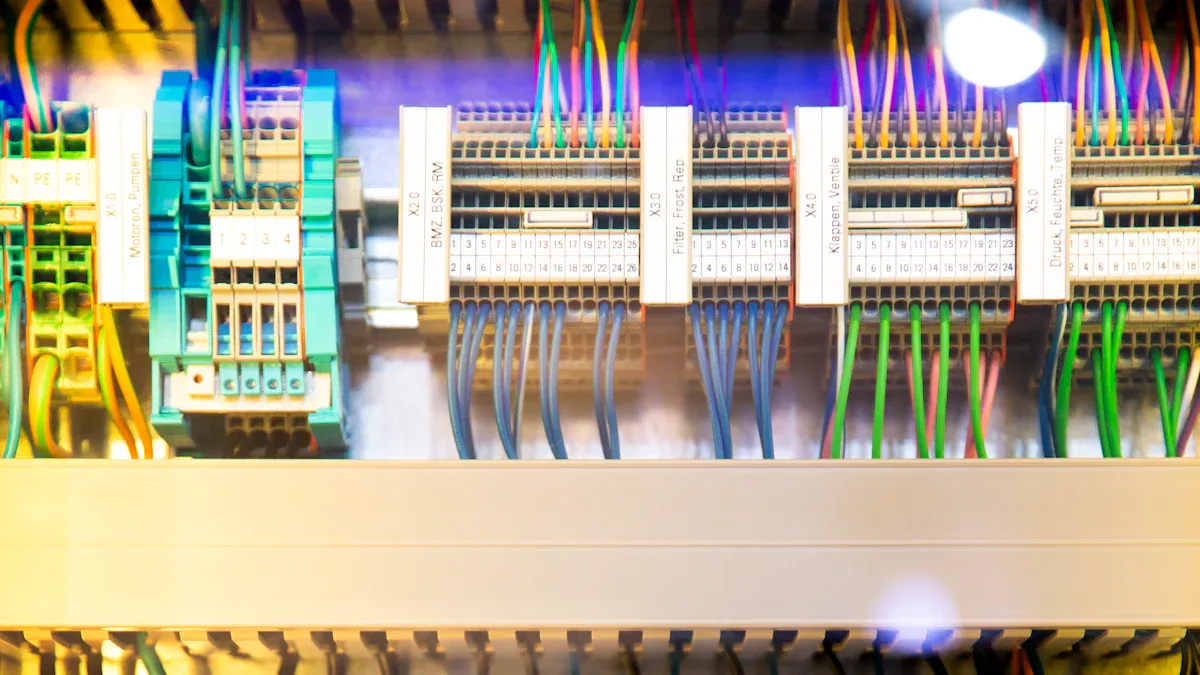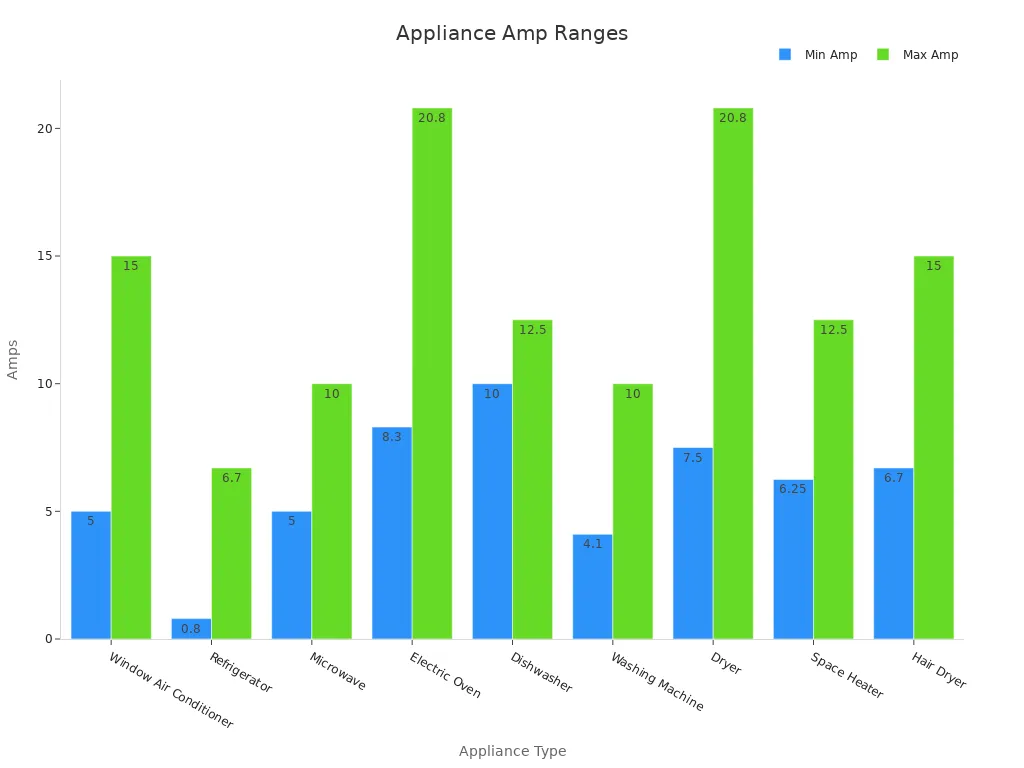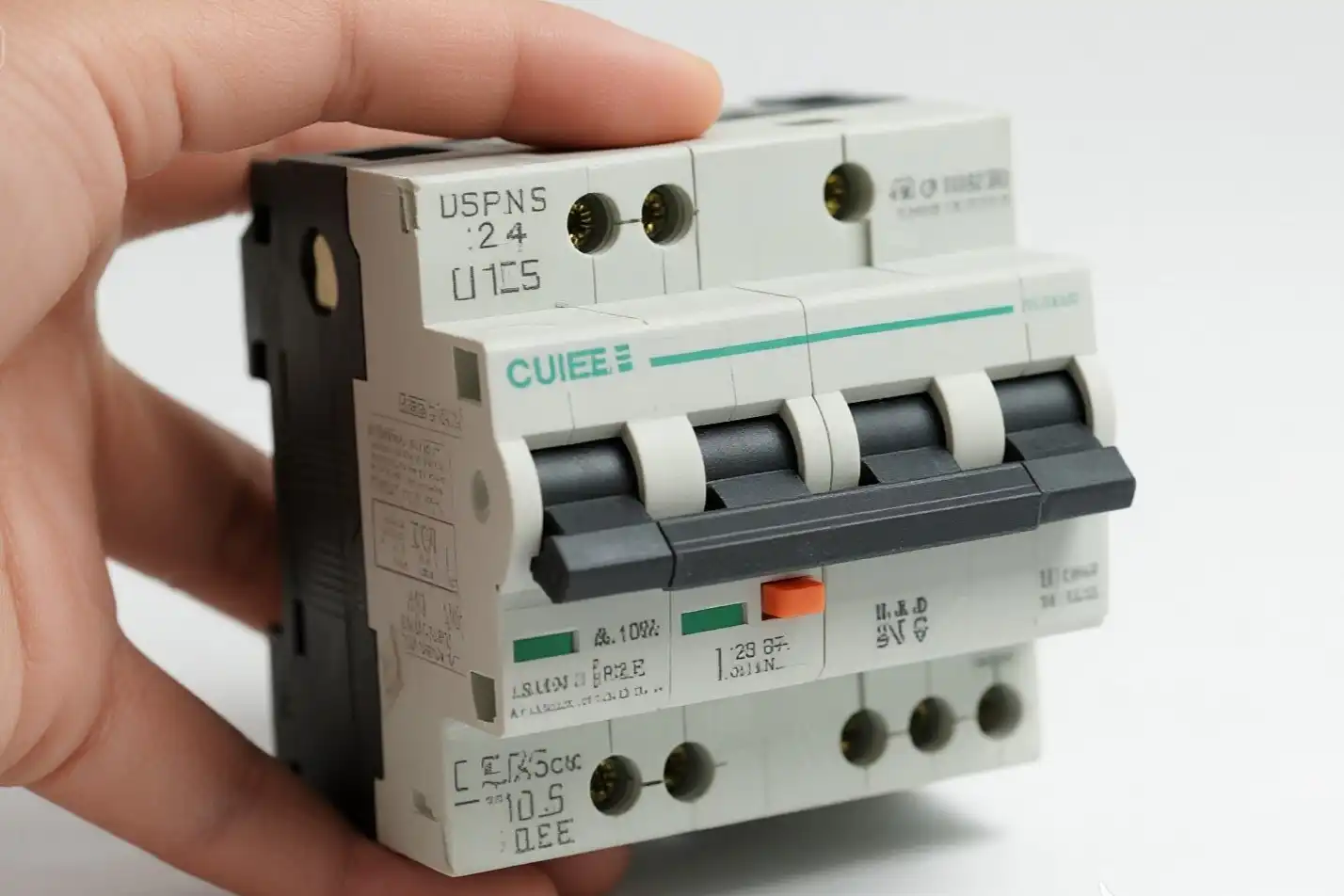You will often see the MCB rating of the house is typically between 6 and 32 amps. This range is essential to keep your wiring and appliances protected by preventing excessive power flow and short circuits. MCBs must comply with strict safety standards such as CE and IEC certifications. They respond quickly to prevent overheating and potential fires.
| Safety Feature | Why It Matters for Homes |
|---|---|
| Certified Ratings | Ensures the MCB rating of the house is reliable and safe |
| Quick Tripping Action | Reduces the risk of fire or electric shock |
Always choose an MCB rating of the house that matches your home’s power requirements and complies with local regulations.
Key Takeaways
- Pick an MCB rating that fits your home’s power use. This helps keep wires and appliances safe from harm or fire. Most homes have MCBs rated from 6 to 32 amps. Smaller ratings are for lights. Bigger ratings are for large appliances. Type B MCBs work best in homes. They trip fast and protect things like lights and outlets. Always follow safety rules and use certified MCBs. Keep the load below 80% of the breaker’s rating to stay safe. Ask a licensed electrician to check your loads. They can help you pick the right MCB. This keeps your home safe and up to code.
MCB Rating of the House

Standard Range
Most homes use an MCB rating between 6 and 32 amps. This range fits many needs in a house. Small ratings like 6A or 10A are good for lights. Medium ratings, such as 16A or 20A, work for things like fridges and microwaves. Big appliances, like air conditioners or ovens, may need up to 32A.
| Circuit Type | Typical MCB Ampere Ratings | Description/Use Case |
|---|---|---|
| Lighting Circuits | 6A or 10A | Low power lighting circuits |
| General Appliances | 16A or 20A | Appliances like refrigerators, microwaves |
| High-Power Devices | Up to 32A | Devices such as air conditioners, ovens |
You should pick an MCB rating that matches the load on each circuit. This helps stop the breaker from tripping when it should not. It also keeps your home safe. The IEC makes rules for these ratings. For example, IEC 60898-1 says MCBs must trip fast if the current is too high. Tests show that MCBs built to these rules trip when needed and keep things cool.
Why It Matters
The right MCB rating protects your wires and appliances. If the breaker is too small, it will trip a lot, even if there is no danger. If it is too big, it might not trip when it should. This can cause wires to get too hot and start a fire.
Tip: Keep the load on an MCB under 80% of its rated current. For example, use a 20A breaker for a circuit that uses up to 16A. This keeps the breaker working safely and protects your home.
The standard MCB rating fits most home electrical needs. For lights and outlets, B-curve MCBs with 6A, 10A, or 16A ratings are best. These breakers trip fast if the current gets too high. This is good for circuits with things like lights and heaters. For big appliances, you might need a 20A or 25A breaker. Always check the real load first.
| Rated Current Range | Typical Application Area | Load Demand Characteristics | Safety and Load Management Importance |
|---|---|---|---|
| Up to 20A | Residential | Low electrical loads typical in homes | Ensures protection for common household circuits, supporting safety |
| 21-50A | Residential and Commercial | Moderate loads in mixed-use environments | Versatile protection for small offices, retail, and restaurants |
The standard MCB rating is not just about rules. It helps keep your home safe and your power working right. Picking the right breaker stops overloads, short circuits, and fires. Always follow local rules and ask an electrician if you are not sure.
Typical Ratings by Circuit
Lighting
Most homes use breakers between 6 and 10 amps for lights. Sometimes, a 15-amp breaker is used for lighting. This follows the National Electrical Code rules. A 15-amp breaker can handle up to 1,800 watts at 120 volts. But you should only use up to 1,440 watts for safety. This is called the 80% rule. For example, you can run about 24 regular 60-watt bulbs on a 15-amp circuit. If you use LED bulbs, you can add even more lights. LEDs use less power.
| Circuit Type | Maximum Amperage | Voltage (V) | Max Wattage | Safe Load (80%) | Typical Use |
|---|---|---|---|---|---|
| Lighting | 15A | 120 | 1800 W | 1440 W | Ceiling and wall lights |
Note: Always check the total watts of all your lights. This helps you avoid putting too much load on one circuit.
Outlets
Outlet circuits usually have breakers rated at 15 or 20 amps. The National Electrical Code says to use 15-amp circuits for most outlets. Use 20-amp circuits in places like kitchens or laundry rooms. A 15-amp circuit can safely power about 8 to 10 outlets. A 20-amp circuit can handle bigger things like microwaves or computers. Homes in the U.S. use copper wires for these circuits. Use 14-gauge wire for 15 amps. Use 12-gauge wire for 20 amps.
- 15-amp outlets: Used in bedrooms, living rooms, and other rooms
- 20-amp outlets: Used in kitchens, bathrooms, and laundry rooms
| Circuit Rating (Amps) | Receptacle Rating (Amps) | Max Load (Amps) |
|---|---|---|
| 15 or 20 | 15 | 12 |
| 20 | 20 | 16 |
Appliances
Appliance circuits need higher amp ratings. Many appliances use more power than lights or outlets. The MCB rating of the house for appliances is between 16 and 32 amps. The rating depends on what the appliance needs. For example, a refrigerator may need a 20-amp circuit. An electric oven or dryer may need a 30-amp or even 50-amp breaker. The National Electrical Code says each appliance circuit must match the appliance’s needs. It also needs extra space for safety.
| Appliance Type | Voltage | Typical Amp Range |
|---|---|---|
| Refrigerator | 120 | 0.8 – 15 |
| Microwave | 120 | 5 – 10 |
| Electric Oven | 240 | 8.3 – 20.8 |
| Dryer | 240 | 7.5 – 20.8 |

Tip: Always use a separate circuit for big appliances. This stops overloads and follows the rules.
Types of MCBs
Type B, C, D
There are three main types of MCBs for homes and businesses. These are Type B, Type C, and Type D. Each type trips at a different current level. This means they react in their own way to sudden high currents.
| MCB Type | Magnetic Trip Setting (× In) | Typical Applications |
|---|---|---|
| B | 3 to 5 | General domestic and resistive loads |
| C | 5 to 10 | Small motors, transformers, fluorescent lighting |
| D | 10 to 20 | Large motors, welding machines, heavy inductive loads |
- Type B MCBs trip when the current is 3 to 5 times higher than normal. You use these for lights, heaters, and most home appliances. They act fast if there is too much current.
- Type C MCBs trip at 5 to 10 times the rated current. These are used with small motors or tools that need more power to start. You might see them in places with power tools or some kitchen machines.
- Type D MCBs trip at 10 to 20 times the rated current. These are for big machines like large motors or welding equipment. Most homes do not need Type D MCBs.
Note: These MCBs can trip in as little as 0.04 seconds or as long as 13 seconds. The time depends on the type and how much extra current there is.
Best for Homes
Most homes should use Type B MCBs. They protect your lights, outlets, and small appliances quickly. Type B MCBs follow the IEC 60898-1 safety rule. This rule is made for homes and keeps your wiring safe.
| MCB Type | Tripping Current Range (× rated current) | Typical Application |
|---|---|---|
| Type B | 3 to 5 | Residential lighting, heating, small appliances |
- Type B MCBs are small and fit easily in your breaker box.
- They are not expensive and do not need much care.
- Type B MCBs do not trip for no reason. They work well for most home circuits.
Tip: Pick MCBs that are made for homes and have the right safety labels. This helps you follow the rules and keeps your house safe. If you have special machines, ask an electrician if you need a different type.
Choosing the Right MCB
Load Calculation
You need to know how much power your home uses before you pick an MCB. Start by adding up the wattage of all devices on a circuit. Divide this total by the voltage (usually 120V or 240V in the U.S.). This gives you the current in amps. For example, if your lights and appliances use 2,400 watts on a 120V circuit, the current is 20 amps.
Tip: Always add a safety margin of 25–30%. This helps the MCB handle small surges and keeps your wiring safe.
- Use copper wires for better safety and performance.
- Check the material type because aluminum wires need different sizing.
- Case studies show that using a safety margin prevents tripping and overheating.
- Simulations with tools like POWER WORLD SIMULATOR confirm these calculations work in real homes.
You should always round up to the next standard MCB size. If your calculation gives you 18 amps, choose a 20A breaker. This method helps you select the right MCB rating of the house for each circuit.
Safety and Compliance
You must follow safety rules when choosing an MCB. The IEC 60947-2 standard says MCBs must trip right away during a short circuit. This protects your home from fires and shocks. Most homes need an MCB with a breaking capacity of at least 6,000 amps (6kA). This means the breaker can safely stop very high currents during a fault.
- MCBs must pass tests for ultimate breaking capacity (Icu) and service breaking capacity (Ics).
- For example, a breaker rated at 15kA can stop a huge fault once, and at 10kA it can do this three times without damage.
- Pollution degree 2 is best for homes. It stops leaks and arcs that can cause danger.
- Always look for certification from trusted labs. This proves the MCB meets safety standards.
You should always follow local codes and ask a licensed electrician if you are unsure. Picking the right MCB keeps your home safe and your power reliable.
Choosing the right MCB rating for each circuit keeps your home safe and your devices protected. You lower the risk of fire and electrical accidents when you match the breaker to the load.
- Always follow safety codes.
- Pick certified MCBs.
- Ask a licensed electrician for help.
Tip: Never guess the right breaker size. A professional can check your wiring and make sure you meet all safety rules.
FAQ
What does MCB stand for?
MCB stands for Miniature Circuit Breaker. You use it to protect your home’s electrical circuits from overloads and short circuits. It acts as a safety switch that trips when the current gets too high.
What happens if you use the wrong MCB rating?
If you use an MCB with a rating that is too high, it may not trip during an overload. This can cause wires to overheat. If the rating is too low, the breaker may trip too often.
What is the difference between Type B and Type C MCBs?
Type B MCBs trip faster and work best for home lighting and outlets. Type C MCBs handle higher surges and suit small motors or power tools. You should use Type B for most home circuits.
What is the breaking capacity of an MCB?
The breaking capacity shows how much fault current the MCB can safely interrupt. For homes, you need an MCB with at least 6,000 amps (6kA) breaking capacity. This keeps your wiring safe during short circuits.
What should you check before choosing an MCB?
You should check the total load on the circuit, the wire size, and the type of devices connected. Always follow local codes and use certified MCBs for safety.
The following information may be of interest to you
How to Distinguish Between Industrial and Residential Circuit Breakers?
Which type of MCB is most suitable for building wiring
How to Match the Type of MCB to Your Electrical Load
Understanding a and b Contacts in Circuit Breakers
The difference between miniature circuit breakers and fuses




